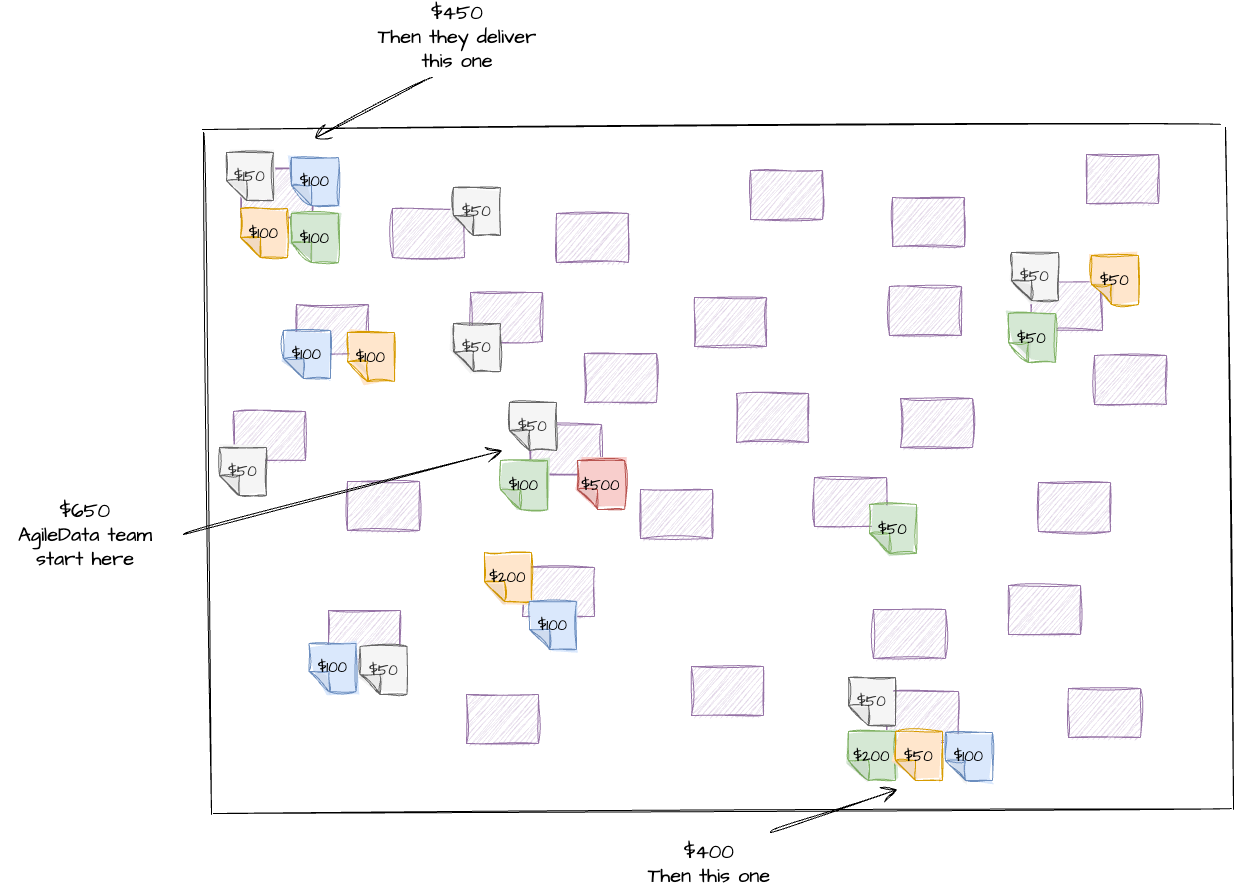Pattern Storming - 500 Dollars Prioritisation
Whats on first, what’s on second, what’s on third?
There are a number of prioritisation patterns from the agile and product domains which have proven as being valuable when used to prioritise work in the data domain.
One of these is the 500 Dollars prioritisation pattern.
We use the Information Product Canvas as the input for this prioritisation pattern.
500 Dollars Prioritisation
This is another one of my favourite patterns to help stakeholders define the priority of the data work to be delivered.
The $500 Prioritisation pattern storming is a simple and creative way for stakeholders to prioritise the highest-value data work. By allocating a virtual $500 budget to each stakeholder, it encourages critical thinking using a constraints pattern, forcing stakeholders to clarify what matters most.
The $500 Prioritisation pattern storming is a simple and creative way for stakeholders to prioritise the highest-value data work. By allocating a virtual $500 budget to each stakeholder, it encourages critical thinking using a constraints pattern, forcing stakeholders to clarify what matters most.
This prioritisation pattern storming process is repeated periodically, allowing data priorities to change as organisational needs evolve.
500 Dollars Pattern Storming Process
Prepare the Cards
The first step is to create cards, one for each Information Product Canvas.
These cards can either contain just the Information Product Name, or you may want to include a subset of the information from the canvas, for example the Product Owner name and T-shirt sizing or the Vision statement.
You need to provide enough information for the stakeholder to quickly glean what the Information Product is about. We will often use a card with just the Information Product name and then have copies of the Information Product Canvas readily available if the stakeholder needs more information.
Setup 500 Dollars board
The second step is to set up a physical or virtual board with all the Information Products cards on it.
Identify the key prioritisation stakeholders
Next you identify the group of stakeholders who will attend the prioritisation workshop and undertake the prioritisation process. These should be the people in the organisation who can make the prioritisation decisions, not people who have been delegated to attend the prioritisation workshop because the key stakeholders are too busy, or not interested.
Book a time that is suitable for all stakeholders to attend. The initial prioritisation workshop should take one hour.
Gather the stakeholders and explain the process
Once the stakeholders have gathered for the workshop, explain they are going to work together to prioritise the work that will be done over the next three months and that they will use the Information Product pattern to streamline the process.
Explain what an Information Product Canvas is by talking them through one of the canvases.
Outline there are more Information Product Canvas defined than can be delivered within the current three month delivery window. We are focussed on prioritising the data work that will be delivered over the next three months, and we will quickly prioritise the most important Information Product Canvas in this initial workshop.
Another prioritisation workshop will be run in two months time to prioritise the following three months, and to ensure re-prioritisation can happen to reflect any changes in organisational priorities that have happened over that time. This pattern of re-prioritising the Information Product Canvas is rinsed and repeated every three months.
Show me the Money
Next we provide the stakeholders with $500 of virtual money.
If we are running an in person workshop we use Monopoly money, fake money from a dollar store or print out and cut out fake money. Only use the large denominations, don’t use the $1 or $5.
If we are using a virtual board we either create post it notes with virtual currency ($10, $20, $50, $100) so stakeholders can copy and paste them, or we ask the stakeholders to use the text option to type in the amount next to each card.
Put the Money where the priorities lay
Ask the stakeholders to place their fake money on the Information Product cards that are the highest value to them, until they have spent all their fake money.
The money can go on any card and they can place as much or as little money on as many cards as they want.
The AgileData team will start with the first Information Product / card that has the highest amount of money assigned and once they have completed delivery of that Information Product they will start on the one with the next highest amount of money.
There is one Rule:
Stakeholders are not allowed to touch other Stakeholders' money.
There are five polices are:
Stakeholders can put as much or as little money as they want on each card, putting $500 on one card is acceptable.
Stakeholders do not need to spend the full $500
Stakeholders can influence other stakeholders to spend money on the cards they think are the highest priority.
Stakeholders cannot bully other stakeholders.
If there is a HIPPO in the room they should place their money down last.
If there is a tie in terms of dollars, for example two cards both are the highest with $450, then the stakeholders can decide to do another round and move some of their money to change the priority. If there is still a tie for the highest priority then the AgileData team decides which one they will work on delivering first.
The process is completed when Stakeholders have either run out of fake money or have decided they will not spend anymore.
The entire prioritisation process should take less than one hour to complete. If you have a consistent set of stakeholders for each workshop, then you will find the process will take less time and less time as they become more familiar with the process.





